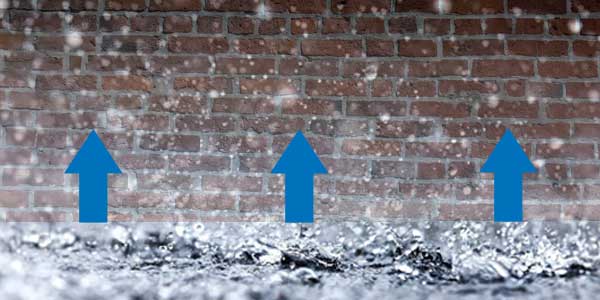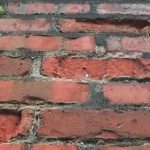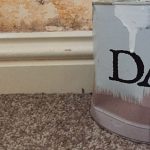The DIY Fix is reader supported. When you buy after clicking a link on our site, we may earn an affiliate commission.
During this article, we’re going to discuss whether rising damp gets worse when it rains. The information is intended to help you diagnose damp in your house. Once you have diagnosed the problems, you can use the rest of the information to stop it returning.
So, does rising damp get worse when it rains? The quick answer is yes. If your property already suffers with rising damp, heavy rain will usually make it worse.
Bricks and mortar are porous materials, and this means they draw water out of the ground and into the structure of your building. When there’s rainfall, there is more water in the ground. This means your building can soak up more water. As the footings and bricks soak up water, the level of the damp rises. Hence the name.

The masonry in your property will keep soaking up moisture until gravity stops it. This is usually at around the one-metre mark. At this point, the damp level will build up in the affected area. So, yes, rising damp will get worse with rain. The problem is, identifying rising damp early is tricky.
Identifying rising damp
As this type of damp affects the brickwork of your home first, it can be challenging to spot. It’s hard to spot rising damp because a lot of identifying signs can be hidden from view in the early stages. For example, early warning signs can be masked by skirting boards. Or the signs can be in the walls under your floorboards. So, what are the signs of rising damp that you can look for?
- Any areas of blistering paint, peeling wallpaper or stained plaster around floor level
- White marks: these could be signs of salt deposits from minerals in the soil rising through the brickwork
- Decaying wood, such as, skirting, floor joists and floorboards.
- Mould and discolouration
- Musty/damp smell
- A deterioration of the mortar joints
In most rising damp cases, the first sign that a homeowner will have is the smell. As this damp may be affecting brickwork and timbers in areas of a room that aren’t visible, your nose will often spot the signs first. If you can smell a mouldy odour, check the room. See if any areas have regular condensation. Also, note whether your home feels overly humid. These are some of the early warning signs.
The causes of rising damp
The biggest cause of rising damp is not having a damp proof course. Or, having a damp proof course that either, wasn’t installed properly, or one that is faulty due to age. A damp proof course is a barrier. It prevents moisture from rising from the ground into the structure of your building. As we mentioned earlier, your property can soak up water through the brickwork and concrete footings. This protective layer is designed to stop this happening. It blocks moisture being soaked up by the porous materials in your home.
Because rising damp is challenging to spot early on, it means that homeowners can often misdiagnose this type of damp. This can lead to costly solutions to problems that are not there. As we mentioned, typically, the first sign of rising damp in your home is a mouldy smell. Still, that is true for other forms of damp too. So, how can you tell rising damp from other forms of damp
Is rising damp the cause of the moisture in my home?
If you have noticed a mouldy smell in your home, it doesn’t always mean that you have rising damp. Your property could be suffering from more common forms of damp, such as penetrating damp. Penetrating damp is also increased by heavy rainfall. This often occurs when moisture finds its way into your property through defects in the brickwork. This type of damp will usually leave isolated patches of moisture on your walls. Note the word “isolated”.
So, how can you tell these two types of damp apart? Well, rising damp flows up your walls. Penetrating damp comes through your walls and shows in isolated areas. Also, with rising damp, you can often see white marks, like tide marks, on your wall. These white areas are minerals that have risen through the brickwork of your home. This only occurs with rising damp because the moisture is rising from the ground. If you have white tide marks on your wall, it is very likely you have rising damp. If you have isolated patches of damp, then it is more likely that you have penetrating damp.
A good way to check for rising damp is to follow the moisture down. If you have moisture on your wall, feel below it. The likelihood is that if one area of your wall is affected, the area below it will be too. Look for the signs of this type of damp mentioned above. If you find them, the likely cause of your damp issues is rising damp. If the wall below the area you noticed is dry, it is more likely to be penetrating damp.
How to prevent and stop rising damp
Rising damp often goes on in the walls of a building undetected for ages. This slowly damages the structure. Some people only notice this damp when the mortar between the bricks starts to crumble and protrude. Thankfully, though, even at this stage, rising damp can be treated. That is, if the property owner acts relatively quickly. If they don’t, the problem is likely to get worse.
So how do you stop rising damp? Remember the damp proof course we mentioned earlier? To stop rising damp, you must ensure the property has a suitable damp proof course. The most common method of creating this is by injecting chemicals into the mortar of your home. This creates a barrier, just like a traditional damp proof course. It will stop any more moisture flowing into your brickwork and mortar.
Depending on the damage to the structures in your home, you may also need to do other repair work. You may need to replace floor joists, flooring, skirting, even plaster as well. You will need to dry the parts of your property affected correctly. This depends on how bad the rising damp is, of course. If you have spotted the damp early, it might just be a case of drying out the walls, skirting and flooring, for example. You will also need to Air out the property and ensure all the moisture has gone. Then give the affected areas a coat of fresh paint or reapply wallpaper.
Conclusion
So, as we have demonstrated in this article, rising damp can get worse when it rains, and it can be tricky to spot. However, if you think you have rising damp, then installing a chemical DPC, could be a low cost and simple solution. You can see a good example of a chemical DPC here on Amazon. On the other hand, if your still not sure, it is recommended that you seek the advice of an expert.
Finally, if you have noticed damp in your property, but are now thinking your problem is not rising damp. Make sure you check out the rest of our website. We have lots of articles about damp just like this one. They can help you identify which damp you have and how to treat it. The good news is all types of damp are treatable. Even if they have been present for a long time. In lots of cases, there will be a simple DIY damp solution that can solve your problem.




